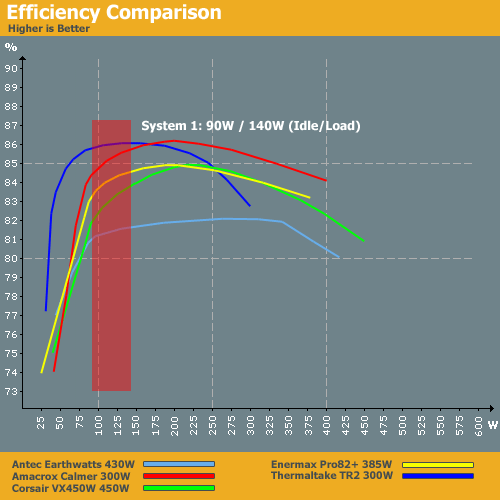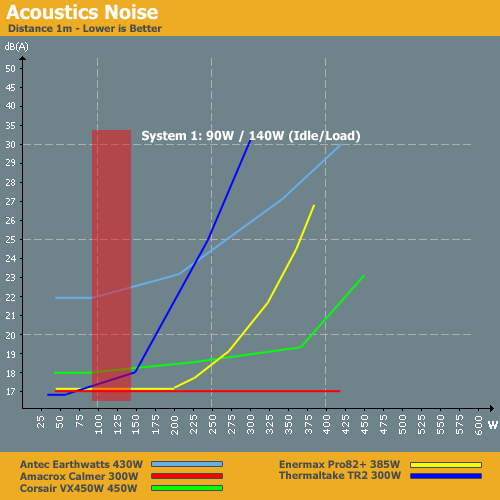Debunking Power Supply Myths
by Christoph Katzer on September 22, 2008 3:00 AM EST- Posted in
- Cases/Cooling/PSUs
Making Compromises
What we have learned from the preceding PSU example? A higher rated power supply will run much quieter if it runs at less than 50% of its rated output, but you don't want the rating to be too high or else efficiency will drop. Now we come to the more complicated part of choosing the right power supply for a new system. You need to make compromises between achieving optimal efficiency and maintaining a quiet working environment. If that is your goal, our high-end sample system is a perfect candidate for a 900W power supply like the Cooler Master UCP 900W. Efficiency is very good throughout the operating range and noise levels will be far lower than the ambient noise from the rest of the system. What we want to do now is go through the three sample systems and select an appropriate power supply.
Our entry-level system has very low power consumption, and unfortunately most power supply manufacturers completely ignore this market segment. Our goal today is to focus on quality power supplies that are readily available worldwide, and most manufacturers start with 500W models and go up from there. That limits our choices, but there are still a few options.
We can only be sure about efficiency if we've tested a power supply, so we will confine ourselves to such units. (Note that we have not necessarily published reviews on all of these power supplies, but we have tested them.) Our entry-level system uses an ATI Radeon HD 3650 graphics card, which means we don't need a PEG connector; that makes our choices a little easier. We'll focus on the following offerings:
- Thermaltake TR2 QFan (300W) actively cooled
- Enermax Pro82+ (385W) actively cooled
- Amacrox Calmer 560 (300W) passively cooled
- Corsair VX450W (450W) actively cooled
- Antec Earthwatts (430W) actively cooled

In the range of 90W to 140W, it's little surprise that the best efficiency is achieved by the two power supplies with the lowest rating (300W). The Thermaltake TR2 QFan places first in our results, and second place goes to the Amacrox Calmer 560. The Enermax takes third place, Corsair is in fourth, and Antec ranks at the bottom of these five options. If it were possible to find a 250W power supply with similar performance at a lower price, that would be even better, but it's just not possible these days. That takes care of efficiency, but let's look at noise levels.

In the same range of 90W to 140W, the Amacrox Calmer 560 and Enermax Pro82+ are the best performers, with the overall crown going to Amacrox, since the Calmer 560 is passively cooled. The Thermaltake TR2 QFan and Corsair VS450W aren't too far behind, at only 18 dB(A) max, while Antec brings up the rear again.
Looking at the above two charts, the Thermaltake TR2 QFan is a perfect candidate for our entry-level system. However, if you instead prefer silence, we would go ahead and pick up the Amacrox Calmer 560. The HD 3650 is also available with passive cooling, so you will never have to complain about computer noise. In fact, I have that exact setup and use it daily as my system for web surfing and writing articles.
As the graphs show, there's still plenty of performance available, so we could even make a few system upgrades down the road. In truth, we could run this sort of system with a 200W power supply, but there are no quality PSUs available in that range. The desire for quality is what led us to select the Amacrox, Thermaltake, Enermax, Corsair, and Antec offerings, as they all provide excellent voltage regulation and overall quality.










98 Comments
View All Comments
computerfarmer - Tuesday, September 23, 2008 - link
Good article! Based on the number of comments, this has many of us thinking. This gives a way of figuring out our needs vs bigger is better.This article gives us enough information to make educated choices. Looking at the 12V rails is a good place to start along with total power. With a single 12V rail like Corsair VX series, the amount each rail carries is a non issue.
A rule I have always followed is to use a power supply with at least 20% more power than the maximum required.
dragosmp - Tuesday, September 23, 2008 - link
Hey, I just wanted to say that after posting this link on OCN, there were tenths of replies. People want to know how much various things consume, as all this 1kW PSU hype hype is getting very tiresome.I for one would be curious how did you measure the current thru the PCIe slot - have you modified the slot to access the power lines? Soldering geeks would really like to know :)
And lastly, browser compatibility. This comment is very hard to write in Chrome (writing overlapping), maybe you or google will fix this.
Cheers,
Dragosmp
Fudus - Tuesday, September 23, 2008 - link
I am stupid and run my 4850 off a 300W power supply, with a sata power>molex>pci-E power connection. Go Go overloading!It seems to work at stock speeds under stress as well for some reason. I really didn't expect it to work this well (C2D e6550, Radeon 4850,300W power supply, 2GB RAm, G33 motherboard, 1 HD/DVD+RW)
marc1000 - Tuesday, September 23, 2008 - link
you are not stupid, Fudus. if you sum the power for your c2d (never more than 65w), mobo (40w), ram+HD+DVD (5+15+10) you have 135w. then add the 4850 and you are still fine with a 300w PSU. Like i Said before, I have a 90W CPU (that old Pentium-D, argh!) but run a radeon 3850, so my system consumes about the same energy as yours. and the 300w is working fine with me too. or else I would be a stupid too =Pdragosmp - Tuesday, September 23, 2008 - link
Wow, this gives me hopes to mount a 4670 on a 120W pico-atx powered rig.How is the noise, the +12V level?
oopyseohs - Monday, September 22, 2008 - link
I have seen upwards of 700W while testing on old QuadFX systems with 8800Ultra SLI. I would imagine that Skulltrail overclocked to 4.0GHz (easy) and 2x Radeon HD4870X2's in CrossFireX would demand significantly more than 700W. Of course these systems are rare, but they do technically validate the "need" for power supplies that output 1000W+.In any case, thanks for this article. I think it does a great job of showing why ultra high-output power supplies are not even close to necessary for 99.9% of the computing world.
JarredWalton - Monday, September 22, 2008 - link
I have a Q6600 @ 3.42GHz with dual 3870 cards, and that peaks at around 650W at the outlet. Certainly there are plenty of overclocked PCs that can draw more than 700W... but once you take efficiency into account, my PC is only really using around 520W. I've also tested high-end water-cooled setups with 8800 GTX SLI that topped out at 650-700W power draw as well. I personally think with ultra high-end PSUs that having six 12V rails isn't very useful as well - some of the problems people experience with lesser PSUs simply comes from 12V rail distribution.If you're running dual GTX 280 cards and a quad-core (probably overclocked) CPU, I don't think there's anything wrong with 1000W PSUs. In fact, I know Gary has blown a few 1000W PSUs with his overclocking testing in the past. However, I'm running perfectly happy now with a 3.2GHz quad-core and really don't need even that much CPU performance; it's all about the GPU for games, and CPUs are only really taxed in 3D rendering and video encoding it seems.
Griswold - Monday, September 22, 2008 - link
Now that you made that clear, give us some of your great reviews for reasonably dimensioned PSUs instead of these 600-1000W bricks. :Pwhatthehey - Monday, September 22, 2008 - link
Maybe it's just me, but I sort of got the impression that the reason for this article is precisely that Anandtech is tired of only getting the highest-end power supplies for testing. It's all marketing BS of course: they don't want to limit sales of the $300 1000W PSUs so they only send those out for testing.Or maybe the truth is more nefarious: they figure if they send out a top-quality 1000W PSU that has great efficiency and voltage regulation, unsuspecting buyers will buy their lower wattage parts that might not be all that great? The first is more likely, but it wouldn't surprise me if some of the less expensive 400-500W PSUs (even from major brands) use much cheaper components. Which is why we all want to see them tested, and probably also why the companies don't want to send them out for review.
Martimus - Monday, September 22, 2008 - link
Since this article is about choosing a PSU for a new computer build, it would have been nice to include new components like the P45 chipset, or the new nVidia or AMD graphics cards. I started reading it with the hope of knowing how well the Antec Earthwatts 500W PSU that came with the Sonata III case I bought would be do with various build options. The problem was that with only old equipment being used, I couldn't come to any real conclusion. It seemed to read more like a report to prove a point rather than an actual guide written to help with a new computer build. I am not trying to berate the article, but I just don't see the point of it.